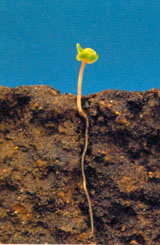IN AUTUMN, when the wide lap of the land is littered with overripe pippin apples and bone-dry cornstalks rattle in the churlish wind, my mind drops down to bedrock and the significant life of soil. There is no better time to cultivate the ground than in the equinoctial seasons, when light and dark dance cheek to cheek and September rain softens the ground. “You open the earth to starlight,” my garden teacher Alan Chadwick often reminded us when he spoke about cultivating the garden, “and induce a capacity for breath in the soil.”
The word soil has deep etymological roots. It derives from the Latin solium, which means “seat” or “throne” and also solum, meaning “ground” or “base.” Dig further and you find the Indo-European verbal root sed, which means “to sit, settle down on the ground,” a fine autumnal practice.
Every kind of soil is composed of weathered mineral bedrock enlivened by both air and water, with a mischievous pinch of organic matter stirred into the brew as primordial yeast. Made of life and death in equal measure, soil is a bridge between worlds, a mystery, a paradox, and a dynamic anchorage for the mind. For while we settle down on bedrock as the solid matrix that grounds and nourishes this fleeting saha world, the very bedrock we trust for stability is alive with change.
My first true encounter with bedrock was at Tassajara Zen Mountain Center monastery tucked deep in the folds of the Ventana Wilderness of central California, where I began to practice meditation and gardening in 1972. Less than two million years old, the bedrock soil of Tassajara is neither tame nor hospitable. A chaos of vertical ridges and steep canyons crimped together in tight accordion folds, the mountains of Tassajara plunge into the Pacific Ocean, where fifty miles offshore they drop twelve thousand feet down into one of the deepest submarine canyons on earth.

The soil I gardened at Tassajara was wild mineral sand, marble, and gneiss bedrock laced with flecks of crystalline amphibolites and infused with a jumble of uplifted metamorphic and sedimentary rock. I touched my tongue to this raw earth on occasion (a member of the youngest, Entisol order of soils), and the bedrock grit left a lingering chalky sweetness that I can still taste at the back of my mouth.
From Tassajara I moved north to practice gardening and Zen at Green Gulch Farm where the bedrock soil is utterly other from that at Tassajara. The compacted clay soil of the Gulch is made of ancient seabottom mixed with a melange of chert, greywacke, serpentine, and basalt, compressed into impenetrable rock where the continental plates rub up against each other along the jagged gash of the San Andreas Fault. This matrix, part of the famously fertile Mollisol order, offers heavy blue, ochre, and burned chocolate clays that grow iron-dark spinach at the edge of the floating world.
Alan Chadwick often said that all soils are beautiful soils and that it is always the garden that makes the gardener, never the other way around. This being so, I am made of the soil of every garden that I have ever worked and been nourished by. I take my place in the evolving order of bedrock ground, from Entisol to Mollisol and beyond, and I am not alone. Recent corings into bedrock four kilometers underground revealed that the stony firmament itself is alive with invisible microbes, dismantling and digesting their rocky world and creating new soil for gardeners to garden.
In this autumn equinox season my gardener’s mind descends into the world of bedrock. At the same time I am studying Shantideva’s eighth-century classic, The Way of the Bodhisattva, a kind of Buddhist bedrock in itself. The text celebrates the mind of awakening, cultivated for the benefit of all being. This stanza (3.21) stepped forth for me this morning before I went out into the garden:
Like the earth and the pervading elements,
Enduring as the sky itself endures,
For boundless multitudes of beings,
May I be their ground and sustenance.
Thank you for subscribing to Tricycle! As a nonprofit, we depend on readers like you to keep Buddhist teachings and practices widely available.